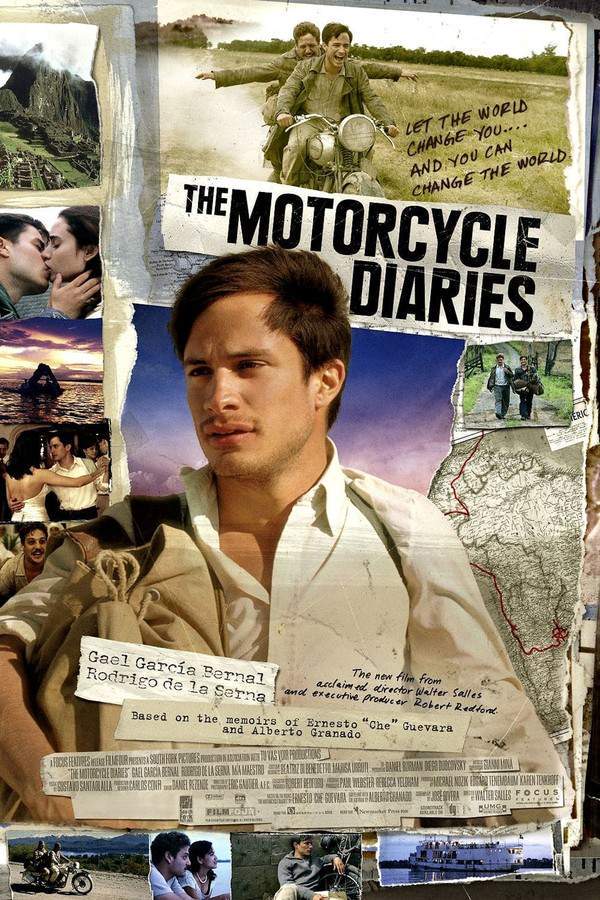The Motorcycle Diaries 2004

In 1952, Ernesto Guevara and Alberto Granado set off on a motorcycle trip across South America. Their journey from Brazil to Peru exposes them to the harsh realities faced by the region's marginalized populations, revealing widespread poverty and social injustice. Witnessing the struggles of the poor and the exploitation of the wealthy profoundly impacts Ernesto, particularly after a deeply moving encounter at a leper colony, shaping his future political views and commitment to fighting for social change.
Does The Motorcycle Diaries have end credit scenes?
No!
The Motorcycle Diaries does not have end credit scenes. You can leave when the credits roll.
Meet the Full Cast and Actors of The Motorcycle Diaries
Explore the complete cast of The Motorcycle Diaries, including both lead and supporting actors. Learn who plays each character, discover their past roles and achievements, and find out what makes this ensemble cast stand out in the world of film and television.
External Links and Streaming Options
Discover where to watch The Motorcycle Diaries online, including streaming platforms, rental options, and official sources. Compare reviews, ratings, and in-depth movie information across sites like IMDb, TMDb, Wikipedia or Rotten Tomatoes.
Ratings and Reviews for The Motorcycle Diaries
See how The Motorcycle Diaries is rated across major platforms like IMDb, Metacritic, and TMDb. Compare audience scores and critic reviews to understand where The Motorcycle Diaries stands among top-rated movies in its genre.

75
Metascore
7.4
User Score


%
TOMATOMETER

0%
User Score

7.5 /10
IMDb Rating

74
%
User Score
Take the Ultimate The Motorcycle Diaries Movie Quiz
Challenge your knowledge of The Motorcycle Diaries with this fun and interactive movie quiz. Test yourself on key plot points, iconic characters, hidden details, and memorable moments to see how well you really know the film.
The Motorcycle Diaries Quiz: Test your knowledge about the transformative journey of Ernesto Guevara and Alberto Granado across South America.
What is the name of the motorcycle they travel on?
La Poderosa
El Grande
La Valiente
El Viajero
Show hint
Awards & Nominations for The Motorcycle Diaries
Discover all the awards and nominations received by The Motorcycle Diaries, from Oscars to film festival honors. Learn how The Motorcycle Diaries and its cast and crew have been recognized by critics and the industry alike.
77th Academy Awards 2005
Music (Original Song)
Writing (Adapted Screenplay)
58th British Academy Film Awards 2005
Best Film


Best Adapted Screenplay
Best Cinematography
Best Original Music
Best Film Not in the English Language
10th Critics' Choice Awards 2005
Best Foreign Language Film
20th Film Independent Spirit Awards 2005

Best Cinematography

Full Plot Summary and Ending Explained for The Motorcycle Diaries
Read the complete plot summary of The Motorcycle Diaries, including all major events, twists, and the full ending explained in detail. Explore key characters, themes, hidden meanings, and everything you need to understand the story from beginning to end.
In 1952, just a semester away from earning his medical degree, Ernesto “Fuser” Guevara sets off on an adventurous journey with his older companion Alberto Granado, a biochemist, as they leave Buenos Aires for an extensive trek across South America. Although they have a noble goal of working in a leper colony in Peru, what initially drives them is the thrill of exploration and joy. Over the course of four and a half months, they plan to traverse more than 14,000 kilometers (8,700 miles), all the while Granado’s intentions include charming as many women as he can along the way. Their adventure kicks off with Granado’s unreliable motorcycle, affectionately named La Poderosa, which means “The Mighty One.”
Their ambitious itinerary leads them north over the Andes, down the Chilean coast, through the scorching Atacama Desert, and into the lush Peruvian Amazon, aiming to reach Venezuela in time to celebrate Granado’s 30th birthday on April 2nd. However, due to mechanical failures with La Poderosa, they frequently find themselves walking and traveling at a much slower pace, delaying their arrival in Caracas until July.
As the journey unfolds, both Guevara and Granado gain profound insights into the stark realities faced by the indigenous population, revealing the painful discrepancies between the affluent “haves,” which they represent, and the oppressed “have-nots.” A poignant episode in Chile exposes them to a destitute couple cast out due to their communist ideals. In a revealing moment, they confide in the couple that they are not in search of work either, which leads them to visit the Chuquicamata copper mine, where Guevara’s indignation boils over at the mistreatment of the workers.
The transformative experience continues at the breathtaking Machu Picchu in Peru, where Guevara reflects on how a once-thriving indigenous civilization capable of such magnificent achievements was ultimately eradicated by the very forces contributing to the urban decay of polluted Lima.
In another striking episode, they dedicate three weeks at the San Pablo leper colony in Peru. Here, Guevara profoundly observes the societal divide: medical staff live on the north side of a river, untouched by the lepers confined to the southern shore. In a brave act of solidarity, Guevara defies the head nun’s directive to wear rubber gloves, opting instead to shake hands with the leper patients, challenging the misconceptions surrounding leprosy.
As the film approaches its climax, Guevara’s awakening thoughts culminate in a heartfelt birthday toast—his inaugural political speech—where he passionately advocates for the unification of South America, emphasizing the need for solidarity among the Mestizo populace. The journey fundamentally alters Guevara’s worldview, instilling seeds of revolutionary thought that would lead him down the path of Marxist activism.
In a symbolic night passage, despite the danger and his struggle with asthma, Guevara swims across the river, opting to spend the night in a leper hut rather than the doctors’ quarters. The poignant journey culminates at an airport, where Granado admits that his birthday is actually on August 8th and that their supposed goal was merely a motivator for the trip. Guevara, having been aware of this all along, shares a knowing glance. The film concludes with the special appearance of the real Alberto Granado, now 82 years old, showcasing photographs from their journey and briefly mentioning Che Guevara’s eventual assassination by the CIA in Bolivia in 1967.
Uncover the Details: Timeline, Characters, Themes, and Beyond!

Coming soon on iOS and Android
The Plot Explained Mobile App
From blockbusters to hidden gems — dive into movie stories anytime, anywhere. Save your favorites, discover plots faster, and never miss a twist again.
Sign up to be the first to know when we launch. Your email stays private — always.
Watch Trailers, Clips & Behind-the-Scenes for The Motorcycle Diaries
Watch official trailers, exclusive clips, cast interviews, and behind-the-scenes footage from The Motorcycle Diaries. Dive deeper into the making of the film, its standout moments, and key production insights.
The Motorcycle Diaries Other Names and Titles
Explore the various alternative titles, translations, and other names used for The Motorcycle Diaries across different regions and languages. Understand how the film is marketed and recognized worldwide.
Quick Links: Summary, Cast, Ratings, More

What's After the Movie?
Not sure whether to stay after the credits? Find out!
Explore Our Movie Platform
New Movie Releases (2025)
Famous Movie Actors
Top Film Production Studios
Movie Plot Summaries & Endings
Major Movie Awards & Winners
Best Concert Films & Music Documentaries
Movie Collections and Curated Lists
© 2025 What's After the Movie. All rights reserved.
















